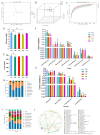Protective Effect of Lactiplantibacillus plantarum 1201 Combined with Galactooligosaccharide on Carbon Tetrachloride-Induced Acute Liver Injury in Mice
- PMID: 34959993
- PMCID: PMC8706614
- DOI: 10.3390/nu13124441
Protective Effect of Lactiplantibacillus plantarum 1201 Combined with Galactooligosaccharide on Carbon Tetrachloride-Induced Acute Liver Injury in Mice
Abstract
Acute liver injury (ALI) has a high mortality rate of approximately 20-40%, and it is imperative to find complementary and alternative drugs for treating ALI. A carbon tetrachloride (CCl4)-induced ALI mouse model was established to explore whether dietary intervention can alleviate ALI in mice. Intestinal flora, intestinal integrity, biomarkers of hepatic function, systemic inflammation, autophagy, and apoptosis signals were detected through a real-time PCR, hematoxylin-eosin staining, 16S rRNA gene sequencing, and so on. The results showed that Lactiplantibacillus plantarum 1201 had a strongly antioxidant ability, and galactooligosaccharide (GOS) could boost its growth. Based on these findings, the combination of L. plantarum 1201 and GOS, the synbiotic, was applied to prevent CCl4-induced ALI in mice. The current research proved that GOS promoted the intestinal colonization of L. plantarum 1201, and the synbiotic improved the antioxidant capacity of the host, regulated the intestinal flora, repaired the intestinal barrier, inhibited the activation of the MAPK/NF-κB pathway, and then inhibited the apoptosis and autophagy pathways, relieving inflammation and liver oxidation; thereby, the ALI of mice was alleviated. These results suggest that synbiotics may become a new research direction for liver-protecting drugs.
Keywords: Lactobacillus plantarum 1201; acute liver injury; galactooligosaccharides; intestinal flora; synbiotic.
Conflict of interest statement
The authors declare that they have no known competing financial interests or personal relationships that could have influenced the work reported in this paper.
Figures







References
MeSH terms
Substances
Grants and funding
LinkOut - more resources
Full Text Sources
Other Literature Sources
Medical

